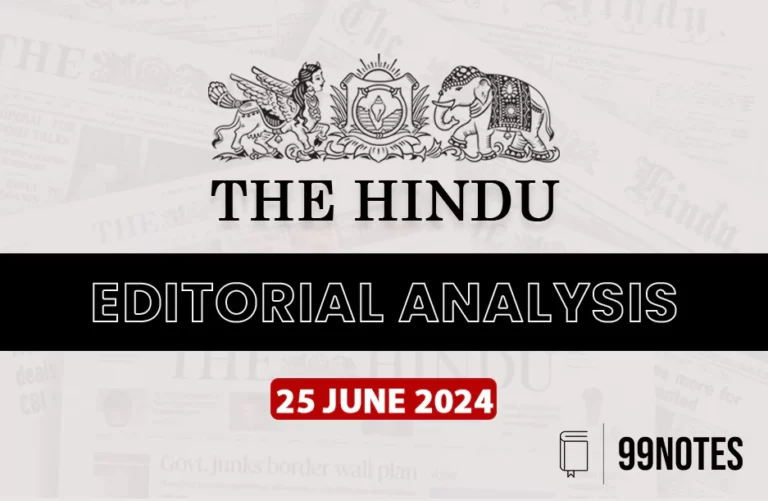9 August 2023 : The Hindu Editorial Notes PDF
The Hindu Editorial
9-August-2023
Daily Current Affairs For UPSC ,The Hindu Editorial Summary
1. Falling short: On the Digital Data Protection Bill, 2023
Topic: GS2 – Indian polity.
Context:
- The Digital Data Protection Bill, 2023, was passed in the Lok Sabha and awaits Rajya Sabha approval.
- The revised version incorporates suggestions from the 2022 version, but consultation details were undisclosed.
- The Bill highlights processing personal data after consent, except for legitimate uses like government services.
Issues raised about The Data Protection Bill of 2022:
- Amendment to the RTI act: The Bill includes a provision to amend the Right to Information (RTI) Act, which has been empowering Indian citizens since its enactment in 2005.
- The enactment of a data protection law does not require any amendment to the existing RTI law, as noted by the Justice A.P. Shah Report on Privacy.
- The DPDP Bill 2022 proposes amendments to Section 8(1)(j) to exempt all personal information from disclosure, raising concerns about transparency and accountability.
- The government’s Power: The DPDP Bill 2022 empowers the executive to draft rules and notifications on a wide range of issues, potentially allowing arbitrary exemptions for certain entities and violating citizens’ privacy.
- Possibility of unfair treatment: The government could potentially exempt its cronies and government bodies like UIDAI, while others would have to comply with stringent data fiduciary obligations.
Issues over the Data Protection Board:
- The oversight body proposed under the DPDP Bill must be adequately independent to act on violations of the law by government entities.
- Issues overhead enemy of data protection board: The draft Bill lacks provisions to ensure the autonomy of the Data Protection Board responsible for enforcing the law.
- The central government is empowered to determine the strength, composition, and appointment process of the board, including the chairperson and other members.
- Autonomy of the Data protection board: The chief executive responsible for managing the board will be appointed by the government, giving it direct control over the institution.
- Potential for misuse of provisions:The creation of a government-controlled Data Protection Board, with the power to impose fines up to ₹500 crore, raises concerns of misuse to target political opposition and critics of government policies.
- Undermines the Right to Information Act 2005: by replacing the high benchmark for exemption with a broad definition of “information related to personal information.
- Lack of legal recourse: Unlike Europe’s General Data Protection Regulation (GDPR), the DPDP Bill 2023 does not address the issue of data collection, and citizens’ ability to seek legal recourse for privacy violations.
Way forward:
- Ensure transparency and public consultation: during the drafting of the DPDP Bill to address concerns and build public trust.
- Establish an independent and autonomous Data Protection Board: to enforce the provisions of the law and protect personal data effectively.
- Clearly define the provisions: regarding the composition, appointment process, and removal mechanisms of the Data Protection Board to prevent undue government influence.
- Strengthen provisions to protect citizens’ right to information: and ensure that the DPDP Bill does not compromise transparency and accountability.
- Conduct a comprehensive debate and discussion in Parliament: to address the shortcomings and implications of the Bill before its enactment.
Model question: Examine the key provisions and objectives of the Digital Personal Data Protection (DPDP) Bill in India. Discuss its potential implications for citizens’ right to privacy, data protection, and transparency. What measures can be adopted to ensure an effective balance between data protection and government’s access to data for legitimate purposes? (20 Marks)
2. The grammar of commerce in a new age of geopolitics
Topic: GS2 – Indian economy.
Context:
- India is a favored trading partner due to its potential for a large market.
- Since March 2018, 23 advanced and developing countries agreed to currency swap arrangements with India.
- These arrangements involve extending credits for settling transactions.
- This indicates India’s growing influence and attractiveness in international trade.
Use of rupee for international payments:
- The Ukraine-Russia war in 2022 led to sanctions by the US and EU on Russia, impacting its financial institutions.
- India and Russia turned to using the Indian rupee for trade transactions due to sanctions.
Potential for Use of rupee for international payments:
- Diversification: Using rupee diversifies global currency options, reducing dependence on traditional currencies.
- Cost Efficiency: Saves on foreign exchange conversion costs, mitigating currency depreciation effects.
- Currency Credibility: Enhances rupee’s credibility and stability in global markets, bolstering its reserve status.
- Geopolitical Flexibility: Facilitates trade in regions constrained by geopolitical factors against other major currencies.
- Sovereignty: Reduces reliance on external currencies, reinforcing economic sovereignty.
- Regional Cooperation: Strengthens regional economic and financial cooperation among neighboring nations.
- Strategic Partnerships: Builds strategic alliances among countries seeking alternatives to conventional global currencies.
- Remittance Simplification: Simplifies remittances for diaspora, reducing costs for overseas workers.
Challenges associated:
- Global Acceptance: Limited global acceptance of the rupee might hinder its use in diverse international transactions.
- Liquidity Concerns: Insufficient rupee liquidity in foreign markets may hinder its smooth use for settlements.
- Exchange Rate Risk: Rupee’s potential depreciation might impact the value of transactions over time.
- Regulatory Harmonization: Variations in regulatory frameworks across jurisdictions could complicate cross-border rupee settlements.
- Geopolitical Factors: Political tensions or conflicts could discourage some countries from using the rupee.
- Technology and Security: Ensuring secure and efficient technology infrastructure for rupee transactions is crucial.
- Cross-Currency Comparison: Lack of standardized cross-currency comparison metrics might deter stakeholders.
- Interoperability: Ensuring seamless interoperability between rupee and other currencies is a complex task.
Way forward:
- Enhance Global Awareness: Promote the benefits of using the rupee for international transactions through campaigns and educational initiatives.
- Strengthen Regulatory Framework: Develop a clear and consistent regulatory framework that facilitates cross-border rupee transactions while ensuring compliance with global standards.
- Expand Market Infrastructure: Invest in building robust market infrastructure for rupee settlements in global financial systems.
- Collaborate with Financial Institutions: Partner with international financial institutions to create and support platforms for rupee-based transactions.
- Liquidity Enhancement: Work towards enhancing rupee liquidity in global markets to facilitate smoother transactions.
- Geopolitical Diplomacy: Strengthen diplomatic ties with potential trading partners to promote the acceptance of the rupee.
- Technology Advancements: Invest in secure and efficient technology solutions to facilitate seamless rupee transactions globally.
- Collaboration in Regional Forums: Engage in regional forums to harmonize regulations and facilitate cross-border transactions involving the rupee.
Conclusion:
The rupee’s international potential rests in diversification, stronger economic ties, among other factors – contributing to India’s global financial standing.
3. Learning from the CHIPS Act of the U.S.
Topic: GS3 – Indian economy.
Context:
- The U.S. CHIPS Act, allocating $52.7 billion over five years for semiconductors, provides lessons for India’s semiconductor strategy.
- The Act’s multi-agency cooperation highlights priority and could guide India to adopt a comprehensive approach.
Status of semiconductor industry in India:
- The semiconductor industry in India is in a nascent stage of development. However, the government is taking steps to promote the industry and make India a major player in the global semiconductor market.
- Government has announced following initiatives for the promotion of semiconductor industry:
- The National Semiconductor Policy 2020:This policy provides a framework for the development of the semiconductor industry in India. The policy aims to make India a global hub for semiconductor design, manufacturing, and testing.
- The Electronics Manufacturing Clusters (EMC) Scheme:This scheme provides financial assistance to states to set up electronics manufacturing clusters. These clusters will provide a conducive environment for semiconductor manufacturing companies.
- The Production Linked Incentive (PLI) Scheme:This scheme provides financial incentives to companies that manufacture electronic products in India.
Significance of the development of semiconductor industry for India:
- Economic Growth: Semiconductor industry growth boosts GDP, job creation, and technological advancement.
- Technology Leadership: Advances in semiconductors enhance India’s tech capabilities and global competitiveness.
- Strategic Autonomy: Self-reliance in semiconductors avoids supply chain disruptions and geopolitical risks.
- Digital Transformation: Enables AI, IoT, 5G, and other emerging technologies for societal transformation.
- Export Opportunities: Semiconductor exports contribute to foreign exchange earnings and trade balance.
Challenges ahead:
- Infrastructure: Building advanced fabrication facilities requires significant investment and technology.
- Global Competition: Facing established semiconductor giants necessitates innovation and differentiation.
- Talent Shortage: Attracting and retaining skilled workforce for chip design and manufacturing is challenging.
- R&D Funding: Sustained investment in research and development is crucial for technological advancements.
- Supply Chain Resilience: Ensuring availability of raw materials and components amid global disruptions.
- Regulatory Framework: Crafting policies to promote industry growth while ensuring ethical and security standards.
- Intellectual Property Protection: Safeguarding innovations from piracy and infringement is essential.
Source: https://www.thehindu.com/opinion/op-ed/learning-from-the-chips-act-of-the-us/article67172378.ece
For Enquiry

9 August 2023 : The Hindu Editorial Notes PDF

9 August 2023 : Daily Current Affairs

7 August 2023 : Daily Answer Writing

8 August 2023 : Daily Quiz

8 August 2023 : PIB

8 August 2023 : The Hindu Editorial Notes PDF

8 August 2023 : Daily Current Affairs

7 August 2023 : Daily Quiz

7 August 2023 : PIB

7 August 2023 : The Hindu Editorial Notes PDF
August- The Hindu Editorial 9 August 2023 : The Hindu Editorial Notes PDF The Hindu Editorial
9-August-2023
Daily Current Affairs For UPSC ,The Hindu Editorial Summary
Facebook-f
Twitter
Youtube
1. Falling…
August Daily Current Affairs 9 August 2023 : Daily Current Affairs Daily Current Affairs
9-August-2023
Daily Current Affairs For UPSC ,Daily Current affairs of The hIndu…
mains answer writing 7 August 2023 : Daily Answer Writing Mains Answer Writing
One of the key components of these exams is the written test, which consists of…
Daily Quiz 8 August 2023 : Daily Quiz 8 August 2023 : Daily Quiz…
August PIB 2023 8 August 2023 : PIB PRESS INFORMATION BUREAU
8-August -2023
Daily Current Affairs For UPSC ,The PIB ( Press Information…
August- The Hindu Editorial 8 August 2023 : The Hindu Editorial Notes PDF The Hindu Editorial
8-August-2023
Daily Current Affairs For UPSC ,The Hindu Editorial Summary
Facebook-f
Twitter
Youtube
1. Neither…
August Daily Current Affairs 8 August 2023 : Daily Current Affairs Daily Current Affairs
8-August-2023
Daily Current Affairs For UPSC ,Daily Current affairs of The hIndu…
Daily Quiz 7 August 2023 : Daily Quiz 7 August 2023 : Daily Quiz…
August PIB 2023 7 August 2023 : PIB PRESS INFORMATION BUREAU
7-August -2023
Daily Current Affairs For UPSC ,The PIB ( Press Information Bureau…
August- The Hindu Editorial 7 August 2023 : The Hindu Editorial Notes PDF The Hindu Editorial
7-August-2023
Daily Current Affairs For UPSC ,The Hindu Editorial Summary
Facebook-f
Twitter
Youtube
1….



